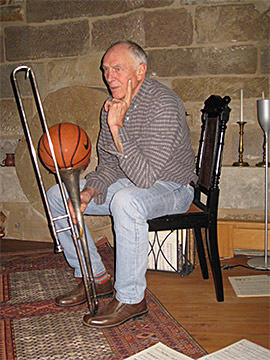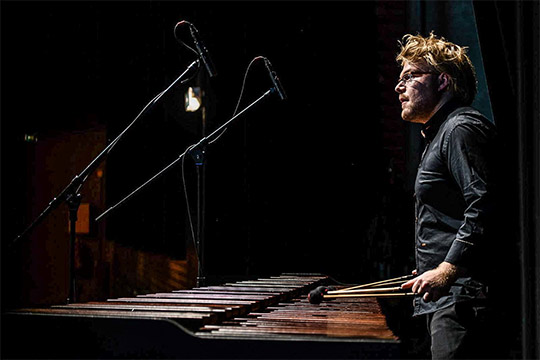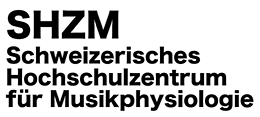Workshops
| Holger Geschwindner1 & Christian Benning2: Basketball is Jazz – The Rhythm of the Game |
| 1Institute of Applied Nonsense and 2Christian Benning, University of Music and Performing Arts Munich |
|
This workshop/ demonstration presents an interdisciplinary project which combines music and sport in an unprecedented manner, taking basketball practice to another level. Benning will present his own invention: an innovative sport/music “hybrid” system, that gives a musical score to the game of basketball. Geschwindner will show how this method can be used to improve the technical efficiency and accuracy of players. End result? Percussion is integrated into basketball training in a way that makes the rhythm of the game accessible to the player. This multi-media presentation includes a live demonstration by professional ball players.
|
| Toni Gruber: Clapping – Stepping – Sticking – Body Percussion |
| University of Music Vienna, Austria/ Bavarian Theater Academy August Everding, Munich, Germany |
|
In this body-music-workshop, we will combine stomp rhythms with hand-to-hand drum patterns, using prepared installation pipes. This method is suitable for physical body training and elementary polyrhythmic experiences with groups.
|
| Clare Guss-West: Restoring Rhythm – The Foundation of Mental Health |
| Dance & Creative Wellness Foundation, Zurich, Switzerland |
|
The ‘Dance for health’ sector addresses today’s insidious epidemic of mental health challenges, prioritizing rhythmic music that intensifies the mental health benefits of dance. Clare explores the evidence-based, use of Rhythm to target specific neurological disorders.
|
| Horst Hildebrandt: Stress Reduction Through Rhythmisation and Self-Hypnosis in the Musical Profession |
| Zurich University of the Arts and Basel Music University, Switzerland |
|
The workshop provides assistance for stress reduction and rhythmisation of work processes for musicians. On the one hand, examples of break structure, differential learning and mental or semi-mental training will be presented. On the other hand, possibilities of muscle and fascia care, regenerating breathing exercises and resource-activating exercises from various self-hypnosis techniques are presented.
|
| Klaus Rom: Rhythm in Training Methods – Why We Should Sometimes Walk in Old Shoes |
| Sport Sciences, Karl-Franzens University of Graz, Austria |
|
Why do experienced runners never throw old shoes away until they are completely worn down, even though they have new ones? Why do we sometimes read about a “complete new” trend in training and rehearsal that we practiced decades ago – and presumed to be complete out of date and unsuitable? Why do young men wear beards again, and after a decade of “eat less fat, live longer,” carbohydrates seem to make us sick? What are the underlying mechanisms of these phenomena, and what can we learn from them in order to find our own way to rehearse and train better?
|


 Holger Geschwindner was born in 1945 and started playing first division basketball when he was a teenager. He has won several championships and captained the German basketball team at the 1972 Olympics. During his playing days, he studied mathematics and physics, read philosophy and literature, and travelled the world. He worked for the Max-Planck-Institute of Psychiatry, built mill wheels in Bamberg, raised a pig named Bruno, saved a pecan nut farm in Mississippi, and hunted wolves around Mount Ararat. Geschwindner has been working with Dirk Nowitzki since 1995. He heads the "Institute for Applied Nonsense" where he still tries to reconcile sports with music and mathematics, physics, philosophy, and psychology.
Holger Geschwindner was born in 1945 and started playing first division basketball when he was a teenager. He has won several championships and captained the German basketball team at the 1972 Olympics. During his playing days, he studied mathematics and physics, read philosophy and literature, and travelled the world. He worked for the Max-Planck-Institute of Psychiatry, built mill wheels in Bamberg, raised a pig named Bruno, saved a pecan nut farm in Mississippi, and hunted wolves around Mount Ararat. Geschwindner has been working with Dirk Nowitzki since 1995. He heads the "Institute for Applied Nonsense" where he still tries to reconcile sports with music and mathematics, physics, philosophy, and psychology. Christian Felix Benning (*1995), multi-percussionist, is from Dachau, Germany. He took his first drum lessons at the age of three and immediately decided to become a percussionist. At 13, he was enrolled as Germany’s youngest precollege student for percussion at the University of Music and Performing Arts in Munich, studying with Dr. Peter Sadlo, Adel Shalaby and Arnold Riedhammer, winning several international competitions with highest scores, and absolving his Bachelor of Music with special distinction in 2019. Beyond his classic musical work and his leading role in a formative cultural project in Mauritius, since 2018 he has been collaborating with Dirk Nowitzki’s mentor Holger Geschwindner in a long-term interdisciplinary project combining percussion with basketball. Benning performances all over the world include concerts at the Elbphilharmonie (Hamburg, Germany), Musikverein (Graz, Austria), Beethoven-Haus (Bonn, Germany) Hercules Hall and Brunnenhof (Munich, Germany) or Century Park (Shanghai, China). He is the recipient of a grant from the German Scholarship Foundation.
Christian Felix Benning (*1995), multi-percussionist, is from Dachau, Germany. He took his first drum lessons at the age of three and immediately decided to become a percussionist. At 13, he was enrolled as Germany’s youngest precollege student for percussion at the University of Music and Performing Arts in Munich, studying with Dr. Peter Sadlo, Adel Shalaby and Arnold Riedhammer, winning several international competitions with highest scores, and absolving his Bachelor of Music with special distinction in 2019. Beyond his classic musical work and his leading role in a formative cultural project in Mauritius, since 2018 he has been collaborating with Dirk Nowitzki’s mentor Holger Geschwindner in a long-term interdisciplinary project combining percussion with basketball. Benning performances all over the world include concerts at the Elbphilharmonie (Hamburg, Germany), Musikverein (Graz, Austria), Beethoven-Haus (Bonn, Germany) Hercules Hall and Brunnenhof (Munich, Germany) or Century Park (Shanghai, China). He is the recipient of a grant from the German Scholarship Foundation. Toni Gruber studied Rhythmics at the University of Music and Performing Arts in Vienna, as well as African Dance with Bob Curtis and Mamadou Fall. Shortly afterwards he got a lectureship in Rhythmics for movement analysis and body education at the University of Vienna. He was instrumental in the founding of the „Bavarian Theatre Academy August Everding Munich“ when he moved to Munich. There he teaches musical and drama students and coaches opera singers in extensive methods of performing movement: body-language-role-finding, rhythm, psychophysical body training, stage fighting as well as African-Latin dance. Toni developed a “stick, stomp & body percussion training.” He invented the ZYKLOKINETIKON – a psychophysical improvisation model for body theater, which is used internationally to train movement actors.
Toni Gruber studied Rhythmics at the University of Music and Performing Arts in Vienna, as well as African Dance with Bob Curtis and Mamadou Fall. Shortly afterwards he got a lectureship in Rhythmics for movement analysis and body education at the University of Vienna. He was instrumental in the founding of the „Bavarian Theatre Academy August Everding Munich“ when he moved to Munich. There he teaches musical and drama students and coaches opera singers in extensive methods of performing movement: body-language-role-finding, rhythm, psychophysical body training, stage fighting as well as African-Latin dance. Toni developed a “stick, stomp & body percussion training.” He invented the ZYKLOKINETIKON – a psychophysical improvisation model for body theater, which is used internationally to train movement actors. Former professional dancer, choreographer, opera director, holistic health practitioner and author, Clare’s specialist work translates Attentional Focus research findings for direct dance practice. Findings are adapted as complementary tools for dancers, teachers and healthcare practitioners enhancing physical and mental performance. Clare teaches this work for such companies as Finnish National Ballet, Houston Ballet, The Royal Ballet and lectures on Senior Dance Practice, MAS Dance Science programme, Bern University and for the Royal Academy of Dance. Director of the ‘Dance & Creative Wellness’ Foundation, Clare leads an international benchmarking initiative for the sector and lobbies for the validation of dance in innovative preventative healthcare.
Former professional dancer, choreographer, opera director, holistic health practitioner and author, Clare’s specialist work translates Attentional Focus research findings for direct dance practice. Findings are adapted as complementary tools for dancers, teachers and healthcare practitioners enhancing physical and mental performance. Clare teaches this work for such companies as Finnish National Ballet, Houston Ballet, The Royal Ballet and lectures on Senior Dance Practice, MAS Dance Science programme, Bern University and for the Royal Academy of Dance. Director of the ‘Dance & Creative Wellness’ Foundation, Clare leads an international benchmarking initiative for the sector and lobbies for the validation of dance in innovative preventative healthcare.
 Born in 1977 in Klagenfurt/Austria, he studied Physical Education and Physics at the K.F. University in Graz. Since 2003, he teaches and does research at the institute for sport sciences of the K.F. University, and at school. His scientific focus is on the theory of sports training. As an experienced mountaineer and triathlete (Olympic distance and Ironman), he discovered that being different is a relevant factor to be successful in competitive situations. Besides his physical activities, Klaus Rom is an experienced saxophone and guitar player, father of three kids, husband, keeper of about 15 sheep and up to 10 chickens, and – guess what – never bored.
Born in 1977 in Klagenfurt/Austria, he studied Physical Education and Physics at the K.F. University in Graz. Since 2003, he teaches and does research at the institute for sport sciences of the K.F. University, and at school. His scientific focus is on the theory of sports training. As an experienced mountaineer and triathlete (Olympic distance and Ironman), he discovered that being different is a relevant factor to be successful in competitive situations. Besides his physical activities, Klaus Rom is an experienced saxophone and guitar player, father of three kids, husband, keeper of about 15 sheep and up to 10 chickens, and – guess what – never bored. The early bird catches the worm!
No matter if you are already registered or missed the deadline for the reduced symposium fee, it’s still possible to be an EARLY BIRD. ...
The early bird catches the worm!
No matter if you are already registered or missed the deadline for the reduced symposium fee, it’s still possible to be an EARLY BIRD. ...



